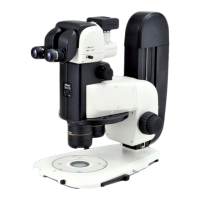Chapter 8 Functions and Operations of the Devices
99
4
Objectives
The microscope system supports the following objectives.
Attach the objectives to the zooming body or intelligent nosepiece.
Model name P2-SHR Plan Apo 0.5X P2-SHR Plan Apo 1X P2-SHR Plan Apo 1.6X P2-SHR Plan Apo 2X
Magnification 0.5x 1x 1.6x 2x
Numerical
aperture
(maximum)
0.078 0.156 0.25 0.312
Working
distance
71 mm 60 mm 30 mm 20 mm
Parfocal
distance:
150 mm 150 mm 150 mm 150 mm
Objective mount Exclusively-shaped
bayonet
Exclusively-shaped
bayonet
Exclusively-shaped
bayonet
Exclusively-shaped
bayonet
Others With a protection ring With a correction glass With a correction ring
• The 2x objective is equipped with the correction ring for water 0 to 3 mm in depth. The correction ring compensates an
aberration caused by water in the dish. With this objective, select 2x magnification or higher. If magnification less than 2x
is selected, shading will occur or part of the field of view will be missing.
• Attach the 1/4 lambda plate for the coaxial epi illuminator to the position from which the protection ring supplied with the
0.5x objective or the correction glass supplied with the 1x objective has been removed.
Restriction
• When the episcopic illuminator is used, use of the objectives and magnification are subject to some restrictions.
(See “7 Episcopic Illuminator” in this chapter.)
• When the diascopic illuminator is used, use of the objectives and magnification are subject to some restrictions.
(See “8 Diascopic Illuminator” in this chapter.)
Total magnification
The total magnification of the microscope is determined from the formula below:
Total magnification = zoom magnification x objective’s magnification x eyepiece’s magnification
• When using a vertical tube, replace the eyepiece’s magnification with the C mount adapter lens’ magnification to
calculate the total magnification.

